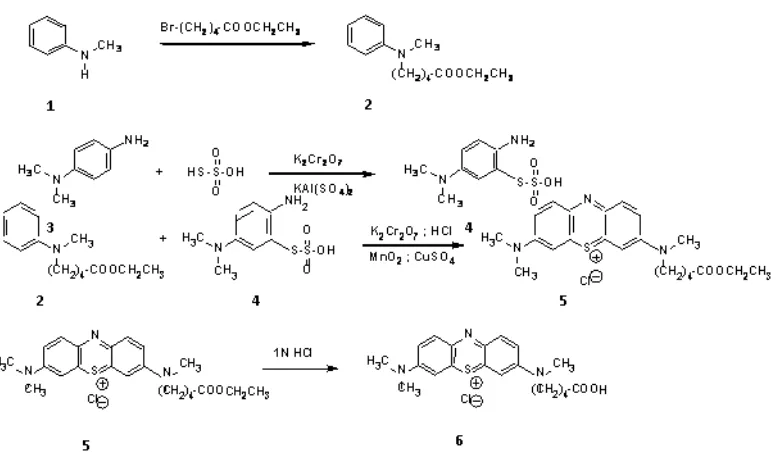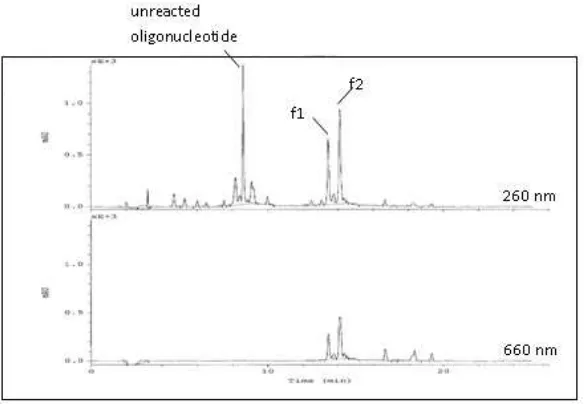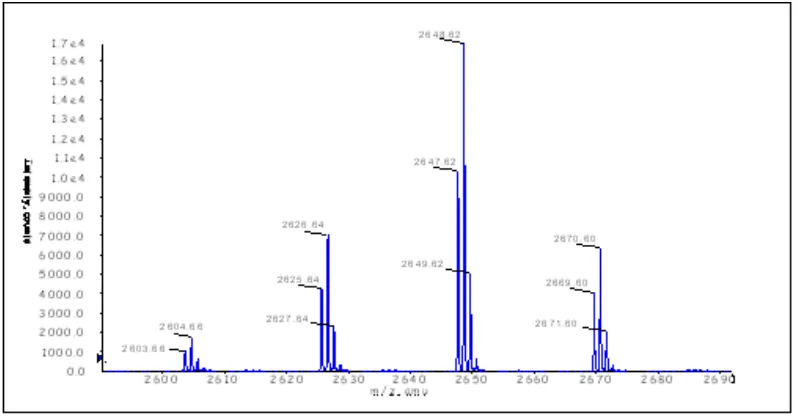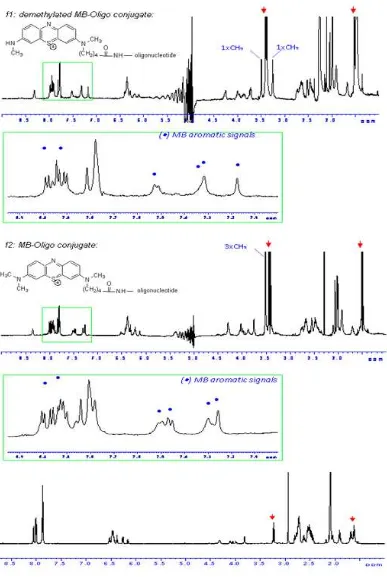ISSN 0973-1792 Volume 11, Number 4 (2015) pp. 475-485 can be used in the development of a new drug that specifically target a DNA sequence. Covalent attachment of the MB to the DNA through a flexible heptamethylene linker has been accomplished, enabling the defined positioning of the dye moiety at specific sites of the DNA strands by forming a triple helix.
The structure of MB itself does not provide a suitable functional group for a direct attachment to an oligonucleotide. Thus, the MB derivative, 3 - N - (4 - carboxybutyl) - methylamino - 7 - dimethylaminophenaza - thionum chloride
was synthesized. The attachment of the MB derivative to a 3’ - aminoalkylated oligonucleotide was accomplished by the activation of the carboxyl group with a yield from 40% - 70%.
A precipitation step using n - butanol was performed before HPLC purification in order to remove the excess of activated MB ester. Unreacted oligonucleotide was identified in the chromatogram from its absorbance at the typical wavelength for nucleic acids and its lack of absorbance at 660 nm. The conjugate products bearing the MB moiety were recognized from the additional absorbance at around 660 nm. Another confirmation comes from the MS data. 1D 1H NMR spectra of the MB - oligonucleotide conjugates as well as the non - conjugated 3’ - aminoalkyl - oligonucleotide in H2O are
acquired to compare the oligonucleotide before and after conjugation with MB.
INTRODUCTION
Triple helical nucleic acids have been known for more than fifty years and interest in these structural variants has considerably enhanced by some recent findings on the existence of triplex - like structures in vivo.1 - 3 Triple helix formation has also been found to offer the basis for numerous site - specific manipulations on duplex DNA. Appropriately designed third strand oligonucleotides targeting a duplex to form a triplex structure might be used to control gene expression by repressing the transcription step, to modulate the sequence - specifity of DNA - binding drugs or to selectively alter the sites of protein activity. Thus, many efforts have been dedicated to modify the third strand for particular purposes, e.g., by covalent attachment of certain ligands to the third oligonucleotide strand. Sequence - specific damage and cleavage of DNA strands employing photosensitizers or/and intercalators tethered to third strand oligonucleotides have also been reported.4 - 6
Methylene blue (MB), a phenothiazinium dye, is a promising ligand that has been shown to interact with DNA and is able to cause a strand cleavage after photoactivation by generating singlet oxygen.7 - 9 This photosensitization process on MB might find its application as a noninvasive therapeutic tool in modern photomedicine, thus making this compound to be of big interest.7 - 10 In order to specify the preferred MB binding location, which in turn may lead to its potential use in the site - directed damaging of DNA targets, we have synthesized a MB -
oligonucleotide conjugate where a MB derivative was covalently coupled to a 3’ - aminoalkyl - modified DNA oligonucleotide third strand by a flexible hydrocarbon linker (Fig. 1). Such a system, we hope, will not only reduce problems due to various stoichiometries, but also will avoid the coexistence of different interactions and lead to the formation of a complex with a better defined structure.
Figure 1: A triplex - forming oligonucleotide conjugated with MB targeting a double helical DNA.
Methylene blue (MB) is a thiazine dye and its formal chemical name is 3,7 - bis(dimethylamino) - phenothiazine - 5 - ium chloride. The pure form of the dye has a dark blue color. MB crystals melt and decompose at 100 - 110oC. It is commercially available mostly as a trihydrate. In a dilute aqueous solution, MB forms a ‘face to face’ dimer and higher aggregates are also formed with increasing concentrations.11 -
13
Figure 2: Reversible redox reaction of methylene blue.
The UV - VIS spectrum of MB in water shows a major absorption in the red region with a sharp peak at 660 - 670 nm and one shoulder at 610 - 640 nm. An absorbance of MB at 665 nm of = 81,600 cm - 1M - 1 was reported.14 There are also less intense peaks in the UV to near - UV region, especially at 284 - 300 nm. The use of MB in biological systems benefits from its major absorption in the red region since light of such a wavelength is minimally absorbed by animal tissue and allows it to penetrate more deeply.
MATERIAL AND METHODS Chemicals
Starting reagents of p.a. quality were purchased from Sigma Aldrich und used without further purification. Solvents for syntheses were dried prior to use when necessary. Deuterated solvents were purchased from Deutero GmbH, Kastellaun, Germany or Cambridge Isotope Laboratory (Euriso - top, GmbH.), Saarbruecken, Germany, and used after addition of dry molecular sieves. Standard oligonucleotides and
oligonucleotides with a 3’ - alkylamino linker were purchased from TIB MOLBIOL, Berlin, Germany.
Mass Spectrometry
A Q - TOF mass spectrometer (Q - Star Pulsar, Applied Biosystems, Foster City, CA, USA) equipped with a nano - electrospray source (Protana, Odense, Denmark) was used. MS spectra were recorded in positive detection mode. For identification the data were analysed with BioanalystTM Software (Applied Biosystems, Foster City, CA, USA) and the integrated Mascot script.
Synthesis of MB - Oligonucleotide Conjugates
Preparation of 5 - (N - Methylanilino) - valeric acid ethyl ester (2)
A mixture of 2.9 g (14 mmol) of 5 - bromovaleric acid ethyl ester and 1.6 g (15 mmol) of N - methylaniline was stirred at 110 oC for 24h. After cooling, a
concentrated solution of sodium hydrogencarbonate was added until pH ≥ 7. The
reaction product was extracted with ethyl acetate and the organic phase dried using sodium sulfate. The solvent was removed under vacuo and the product finally purified through fractional distillation.
1
H NMR (600 MHz, 293K, CDCl3): (ppm) = 1.25 (t, 3H; - CH3), 1.57 - 1.72 (m,
4H; - CH2 - CH2 - ), 2.32 (t, 2H; - CH2CO - ), 2.91 (s, 3H; - N - CH3), 3.32 (s, 2H; - N
- CH2 - ), 4.12 (q, 2H; - O - CH2 - ), 6.67 - 6.72 (m, 3H; H2, H4, H6); 7.20 - 7.25 (m,
2H; H3, H5).
Preparation of 2 - Amino - 5 - dimethylaminophenylthiosulfonic acid (4)
13.6 g (100 mmol) of p - N,N - dimethylphenylenediamine was dissolved in 135 mL of water. 5.4 mL of concentrated sulphuric acid and 2 spoons of active charcoal were added and the mixture heated to 80 oC. The hot purple - coloured mixture was filtered and cooled to room temperature before addition of 57 g (120 mmol) of potassium aluminium sulfate - 12 - hydrate and 29.7 g (188 mmol) of sodium thiosulfate. Following cooling in an ice - bath, 60 mL of an aqueous solution of 7.35 g (25 mmol) potassium bichromate and 6.1 mL acetic acid (96%) were added to the mixture. After stirring overnight the product was filtered and recrystallized from water. Yield: 8.25 g (34%). 1H NMR (600 MHz, 293K, DMSO - d6): (ppm) = 3.00 (s, 6H; N - (CH3)2), the mixture was stirred for about 30 minutes at this temperature followed by another 1 h at room temperature. After filtration, the precipitate was rinsed with water and suspended in 20 mL of acetonitrile. 0.25 g of manganese(IV)oxide and 0.1 g of cupric sulfate were added and the mixture refluxed for 30 minutes. It was subsequently filtered and the filtrate dried under vacuo. Final purification was achieved by column chromatography (SiO2, CH3CN/H2O/1N HCl 40:5:1 v/v/v). Yield: 0.48 g (57%). 1H
NMR (600 MHz, 293K, CD3CN): (ppm) = 1.22 (t, 3H; - CH3), 1.65 - 1.78 (m, 4H; -
CH2 - CH2 - ), 2.38 (t, 2H; - CH2CO - ), 3.32 (m, 9H; - N(CH3)3), 3.65 (t, 3H; - N -
CH2 - ), 4.10 (q, 2H; - O - CH2 - ), 7.10 - 7.80 (m, 6H; ArH).
Preparation of 3 - [N - (4 - Carboxybutyl) - N - methylamino] - 7 - dimethylamino - phenazathionium chloride(6)
the reaction mixture was stirred in the dark for 3 days at room temperature. The solvent was removed under vacuo and the solid residue dissolved in methylene chloride. Washing with a concentrated solution of sodium chloride was repeated until the water phase became almost colourless. The organic phase was dried using sodium sulfate, concentrated under vacuo and purified by column chromatography. Yield: 56 mg (41%. 1H NMR (600 MHz, 293K, CD3CN): (ppm) = 1.82 (m, 4H; - CH2 - CH2 -
), 2.71 (t, 2H; - CH2CO - ), 2.75 (m, 6H; succinimide), 3.32 (m, 9H; - N(CH3)3), 3.69
(t, 3H; - N - CH2 - ), 7.20 - 7.95 (m, 6H; ArH).
Coupling of the MB Derivative with the Oligonucleotide
5 OD of the 3' - aminoheptyl - oligonucleotide was dissolved in 147 µ l of water and 65 µl of 0.1 M phosphate buffer was added (prepared from 0.1M KH2PO4 and
adjusted to pH 8 using 10 N NaOH). 33.5 µl of a DMF solution of the MB N - Hydroxy Succinimide ester 5 (10 mg/mL, corresponding to a 20 fold molar excess) was added and the mixture stirred in the dark for 2 - 3 days. The reaction mixture was monitored by TLC (propanol:H2O 1:1), dried under vacuo and the residue dissolved
in water. About 1 mL of n - butanol was added, the mixture centrifuged at 12000 x g and the supernatant of n - butanol discarded. This step was repeated until the butanol supernatant was almost colourless. The conjugate was finally purified by HPLC. Using Sep - Pak C18 - Cartridges (Waters Corporation, Milford, Massachusetts, USA) the collected fractions were desalted until triethylamine was largely removed as judged by NMR spectroscopy. Yield: 62% (HPLC peak areas).
HPLC Purification of MB - oligonucleotide conjugates
HPLC analysis was carried out with a Hitachi/Knauer system using a linear gradient of 10% buffer A to 40% in buffer B during 20 minutes on a reverse column (Kromasil C18 4x250 mm). A flow of 1 mL/min. was applied and detection was done simultaneously at 260 and 660 nm.
Buffer A : 50% 0,1M triethylammonium acetate + 50% acetonitrile, pH 6.5. Buffer B : 98% 0,1M triethylammonium acetate + 2% acetonitrile, pH 6.5.
RESULT AND DISCUSSION Synthesis of the MB derivative
Figure 3: Synthetic scheme for the methylene blue derivative.
One - dimensional 1H NMR experiments convincingly confirmed the identity of the intermediate products for each synthesis step after separation by column chromatography. However, as seen in the HPLC graph (Fig. 6) two different MB - oligonucleotide conjugates were later isolated. To clarify the origin of the second conjugate, we have performed an initial analytical HPLC separation with a reverse stationary phase on the substituted MB derivative 6 before its activation for coupling with N - hydroxysuccinimide. Interestingly, two fractions inseparable by normal column chromatography were isolated in comparable amounts. FAB mass spectrometry identified these fractions as two compounds with masses of m/z 370.2 and 355.2, respectively. Thus, based on the mass difference of 15, corresponding to a methyl group, and together with other data that will be shown later, the second compound was identified as a demethylated product of the MB derivative. A very similar HPLC profile (not shown) was also obtained when injecting a sample of the commercially available methylene blue. An irreversible photoactivated demethylation has been described in the literature18 and indicated, that the demethylated products were formed during storage.
Fraction - 1 Fraction - 2 Mass: 355.2 Mass: 370.2
Coupling of the MB derivative to a 3’ - aminoalkyl - modified oligonucleotide The attachment of the MB derivative 6 to a 3’ - aminoalkylated oligonucleotide was accomplished by the activation of the carboxyl group (Fig. 3). Using a 7 - mer the coupling with MB succeeded with a yield ranging from 40% - 70% according to HPLC peak integration (Fig. 5 and 6).
Figure 5: Coupling of the MB derivate with a 3’ - aminoalkylated oligonucleotide.
Purification and characterization of dye - oligonucleotide conjugates
Before purification with HPLC, a precipitation step using n - butanol was performed in order to remove the excess of activated MB ester as described in the experimental part. Unreacted oligonucleotide was identified in the HPLC chromatogram from its absorbance at the typical wavelength for nucleic acids (260 nm) and its lack of absorbance at 660 nm. It was isolated as the first fraction eluted from the column. The conjugate products bearing the MB moiety were recognized from the additional absorbance at around 660 nm, which is well known as the λmax for the MB molecule.
There are two product peaks differing in retention time of about 1 minute, f1 and f2, which were detected at both wavelengths. ESI mass spectrometry confirmed the major peak (f2) to be the intact conjugate (Fig. 7), while the mass of f1 points to a demethylated product of f2 (mass spectrum not shown). This agrees with the previous characterization of the two MB derivatives used for the coupling reaction (see Fig. 4).
Figure 7: ESI mass spectrum of f2.
For f2 a mass of 2559.55 Da was calculated. With a peak found at 2603.66 Da this corresponds to a mass difference of 44.11 Da (2 x Na+). Another confirmation comes
from the mass difference of ca. 352 Da with respect to the 3’ - aminoalkyl - modified oligonucleotide and which corresponds to the attached MB moiety.
For comparing NMR resonances of the oligonucleotide before and after conjugation with MB, 1D 1H NMR spectra of the MB - oligonucleotide conjugates as well as the non - conjugated 3’ - aminoalkyl - oligonucleotide in H2O was acquired. There was
CONCLUSION
A MB derivative, 3 - N - (4 - carboxybutyl) - methylamino - 7 - dimethylaminophenazathionum chloride has been synthesized and the attachment to a
3’ - aminoalkylated oligonucleotide has been successfully accomplished by the activation of the carboxyl group with a yield from 40% - 70%. Two different MB - oligonucleotide conjugates were isolated. The second compound has been identified as a demethylated product of the MB derivative.
ACKNOWLEDGMENT
Thank you so much to DAAD for the financial support and to Prof. Dr. Klaus Weisz from the Faculty of Mathematics and Natural Sciences, Ernst Moritz Arndt University, Greifswald, for the facility support and guidance regarding the methods.
REFERENCES
(1) Lee, J. S.; Burkholder, G. D.; Latimer, L. J. P.; Haug, B. L.; Braun, R. P. (1987). A monoclonal antibody to triplex DNA binds to eukaryotic chromosomes. Nucl. Acids Res. 15, 1047 - 1061.
(2) Lee, J. S.; Latimer, L. J. P.; Haug, B. L.;Pulleyblank, D. E.; Skinner, D. M.; Burkholder, G. D. (1989). Triplex DNA in plasmids, and chromosomes. Gene 82, 191 - 199.
(3) Agazie - Jones, S.; Zasloff, M. (1985). Transcription, processing and nuclear transport of a B1 Alu RNA species complementary to an intron of the murine
α - fetoprotein gene. Nature 317, 81 - 84.
(4) Zhou, Y.; Kierzek, E.; Loo, Z. P.; Antonio, M.; Yau, Y. H.; Chuah, Y. W.; Shochat, S.G.; Kierzek, R.; Chen, G. (2013). Recognition of RNA duplexes by chemically modified triplex - forming oligonucleotides, Nucleic Acids Research, 1 - 10.
(5) Rogers, F. A.; Lloyd, J.A.; Tiwari, M. K. (2014). Improved bioactivity of G - rich triplex - forming oligonucleotides containing modified guanine bases, Artificial DNA: PNA & XNA, 5 (1), 27792 - 1 - 27792 - 10.
(6) Glazer, P. M.; Siedman, M. M. (2014). Modified triple - helix forming oligonucleotides for targeted mutagenesis, Patent US 8658608 B2.
(7) Floyd, R. A.; Schneider, Jr., J. E.; Dittmer, D. P. (2004). Methylene blue photoinactivation of RNA viruses. Antiviral Research 61, 141 - 151.
(8) Sahu, A.; Choi,W. I.; Lee, J.; Tae, G. (2013). Graphene oxide mediated delivery of methylene blue for combined photodynamic and photothermal therapy, Biomaterial 34 (26), 6239 - 6248.
(10) Lim, E. J.; Oak, C - H.; Heo, J.; Kim, Y - H. (2013). Methylene blue - mediated photodynamic therapy enhances apotopsis in lung cancer cells, Oncology Reports 30, 856 - 862.
(11) Ghosh, A. K. (1970). Study of the Self - Association of Methylene Blue from Protonation. J. Am. Chem. Soc.92, 6415 - 6418.
(12) Mukerjee, P.; Gosh, A. K. (1970). Thermodynamic Aspeck of the Self - Association and Hydrophobic Bonding of Methylene Blue. A Model System for Stacking Interaction. J. Am. Chem. Soc. 92, 6419 - 6424.
(13) Forlini, S. L.; Sgroi, G. (1981). Solvent Isotope Effect in the Monomer - Dimer Equilibrium of the Methylene Blue. J. Chem. Soc., Faraday Trans. 77, 3049 - 3053.
(14) Liu, Z. - R.; Wilkie, A. M.; Clemens, M.J.; Smith, C. W. J. (1996). Detection of double - stranded RNA - protein interactions by methylene blue - mediated photo - crosslinking. RNA 2, 611 - 621.
(15) Masuya, H.; Shiimadzu, H.; Miyawki, T.; Motsenbocker, M. A. (1992). Photoactive Methylene Blue Dye Derivatives Suitable for Coupling to Protein. EP0510668.
(16) Schubert, F.; Knaf, A.; Möller, U.; Cech, D. (1995). Covalent Attachment of Methylene Blue to Oligonucleotides. Nucleosides & Nucleotides 14, 1437 - 1443.
(17) Jähnchen, J.; Purwanto, M. G. M.; Weisz, K. (2005). NMR and UV Studies on Self - Complementary Oligonucleotides Conjugated with Methylene Blue, Biopolymers 79(6), 335–343.
(18) Mohammad, T.; Morrison, H. (2000). Simultaneous Photoconjugation of Methylene Blue and cis - Rh(phen)2Cl2+ to DNA via a Synergistic Effect.




